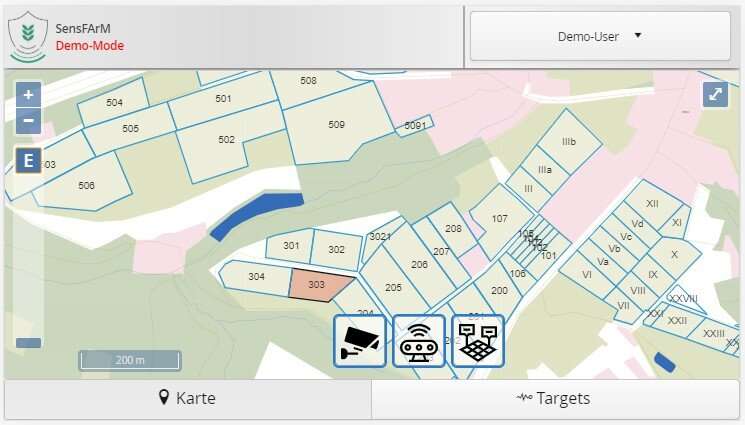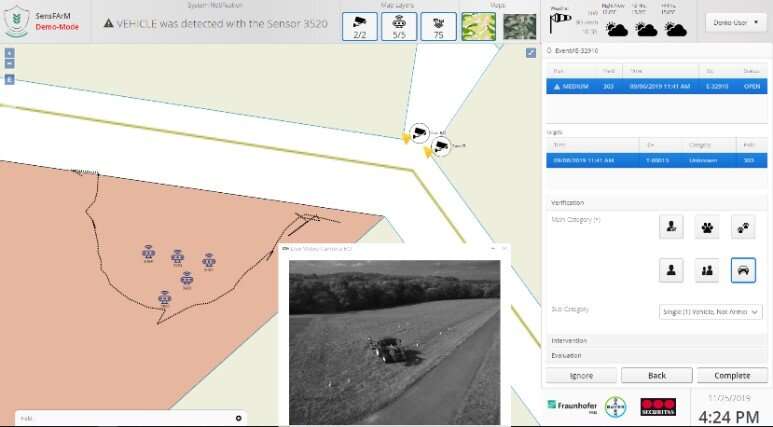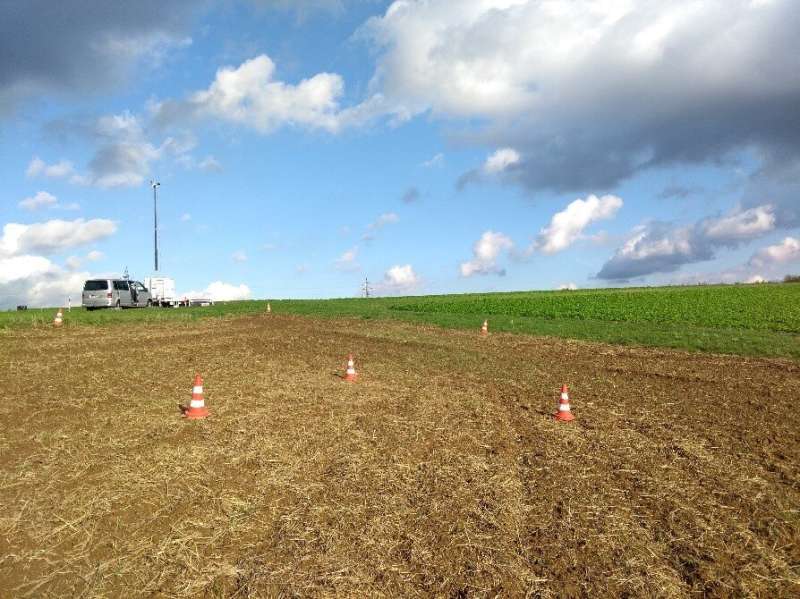An easy-to-read display showing all relevant information for a specific area is available via a mobile app for smartphones or other handheld devices. This provides interactive functionality, enabling users to zoom in for more details, for example, or show additional information. Credit: Fraunhofer-Gesellschaft
The world is having to feed an increasing number of mouths. Studies indicate that global population will rise to over nine billion by the year 2050. In response, Bayer AG is researching resistant cereal varieties and enhanced crop protection. A new 24-hour monitoring system from the Fraunhofer Institute for Communication, Information Processing and Ergonomics FKIE will help protect the fields where these test crops are grown and thereby safeguard this time-consuming and cost-intensive research.
It is no easy task feeding the world's growing population—especially with the challenges posed by climate change. Bayer AG is therefore conducting research into resistant cereal varieties and improved crop protection. These trials are conducted on leased estates and fields that are publicly accessible. As such, there is always the risk that unauthorized persons will intrude and cause damage, by destroying plants, for example, or introducing other species. If not immediately detected, this can set a project back and result in significant financial losses. It is therefore vital that any suspicious activity is discovered as quickly as possible, so that any damage can be checked right away. Yet conventional monitoring systems are unsuitable. This is because test fields are far apart, out of the way and rotate after a year. Crucially, too, there is usually a lack of communications infrastructure.
Low-cost, flexible monitoring around the clock
Working from its headquarters in Wachtberg, near Bonn, the Fraunhofer Institute for Communication, Information Processing and Ergonomics FKIE has developed a system that solves this problem: SensFArM (Sensor-Based Flexible Area Monitoring). "Our system is flexible, scalable, robust and user-friendly," explains Arne Schwarze, research group manager at Fraunhofer FKIE. "It's also the first to enable around-the-clock monitoring." The system must meet three principal requirements. First of all, it must be able to distinguish between vehicles, people and animals. Is that a person in the field or just a deer? Second, the system must be able to localize the disturbance. Where exactly is the person? Third, it must be able to track the movements of an intruder person across the field. This revels whether the whole field is affected or only certain areas.
The system includes an electro-optical camera, an infrared camera and seismic sensors that are buried in the ground and create a network to detect any vibrations. "We can also connect up other types of sensor, including mobile sensors fitted to a drone," Schwarze explains. The information from these sensors is then combined by means of a data fusion algorithm. This pools the strengths of different types of sensor data and thereby avoids false alarms. For example, the motion sensor in the optical camera will react merely to the shadow of a cloud moving across the field. But by adding data from the infrared camera, which only reacts to sources of heat, a more complete picture can be formed. The algorithm also takes account of the conditions under which specific sensors deliver reliable results. "When it's dark, for example, infrared data is more im-portant than optical data," says Schwarze. Time is another key consideration when it comes to assessing risk: if a person dashes into a field to fetch a dog that has discovered a dead rabbit, this is a completely different situation to when an intruder deliberately walks through a crop and shows no sign of leaving.
-
In the security operation center (SOC), security personnel analyze sensor data that is processed by a data fusion algorithm. Credit: Fraunhofer-Gesellschaft
-
Measurement campaigns, testing and a final demonstration were conducted at locations including a Bayer experimental station. This enabled FKIE researchers to collect important data for further development of the solution. Credit: Fraunhofer-Gesellschaft
End-to-end workflow: detection, classification, documentation
The system provides detection, classification and documentation. Security personnel watching the monitors receive onscreen notification of any suspicious event. The system informs them who or what is in the field and assesses the level of risk. In the first instance, the security personnel can take a look at the situation themselves by inspecting video images from the field. After analyzing all the available information, they can then initiate appropriate measures, such as informing certain company employees, dispatching a patrol unit to intervene, or notifying the police. Last of all, the security personnel logs the incident in the system and evaluates the degree of risk: high, medium or negligible. This documentation enables members of the company's own security service to evaluate the incident at a later point in time.
Successful trials
The system has already completed two trials, each lasting a week, at a Bayer location. The final proof of concept demonstration involved a range of scenarios, including the intrusion of unauthorized persons onto the test field. Back in the security operation center, security personnel from Securitas, the security service provider commissioned by Bayer, were able to enact the entire response procedure. In the future, Securitas intends to offer security services built around this new system. This is because the sensor technology can be combined to accommodate many different kinds of challenges that usually defeat conventional monitoring systems. For example, the system could be used to enhance the protection of substations, which in future are to be upgraded with additional technology.
Provided by Fraunhofer-Gesellschaft


























